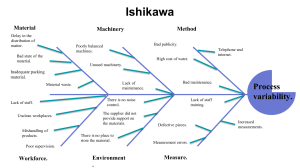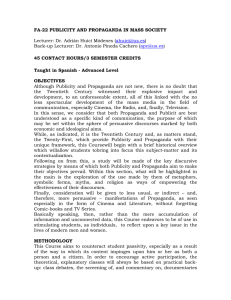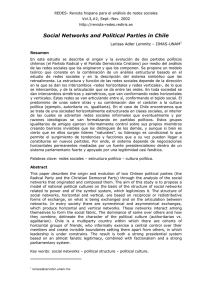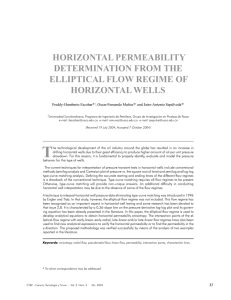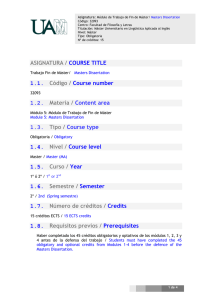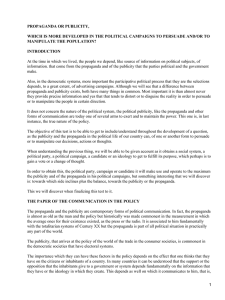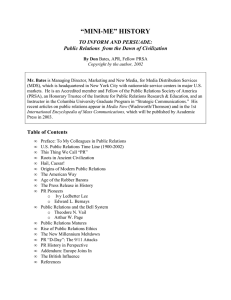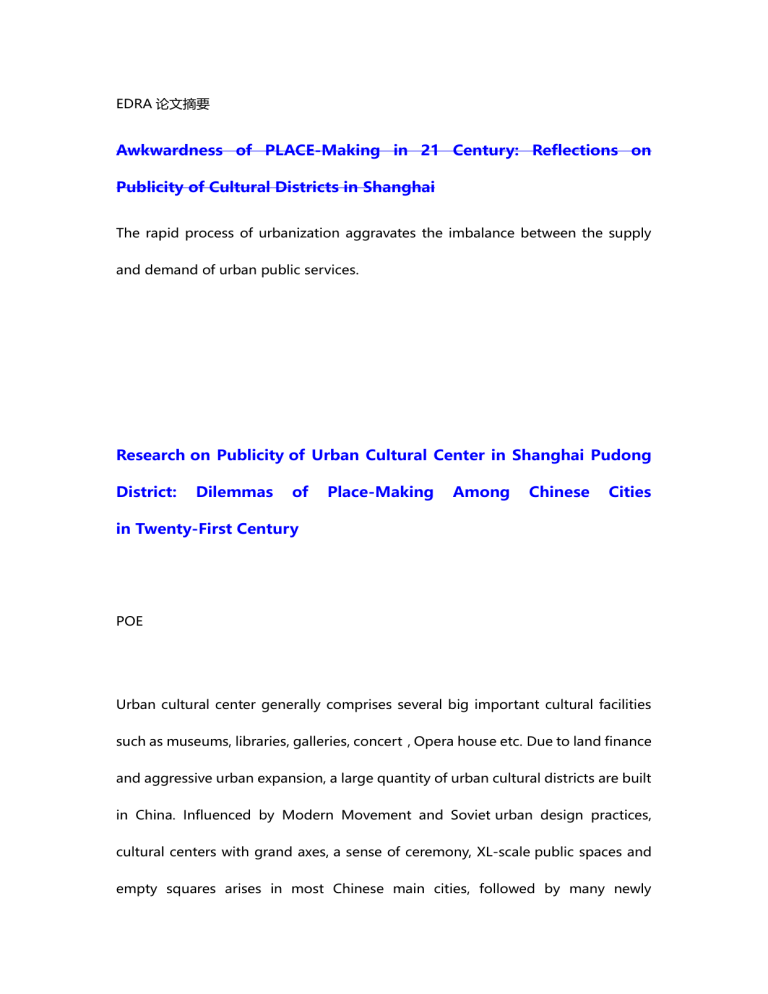
EDRA 论文摘要 Awkwardness of PLACE-Making in 21 Century: Reflections on Publicity of Cultural Districts in Shanghai The rapid process of urbanization aggravates the imbalance between the supply and demand of urban public services. Research on Publicity of Urban Cultural Center in Shanghai Pudong District: Dilemmas of Place-Making Among Chinese Cities in Twenty-First Century POE Urban cultural center generally comprises several big important cultural facilities such as museums, libraries, galleries, concert,Opera house etc. Due to land finance and aggressive urban expansion, a large quantity of urban cultural districts are built in China. Influenced by Modern Movement and Soviet urban design practices, cultural centers with grand axes, a sense of ceremony, XL-scale public spaces and empty squares arises in most Chinese main cities, followed by many newly developed ones and. In the XXI century, cultural districts gained a major role in urban public lives and public spaces. However, obvious issues, for instance, a lack of vitality, low efficiency, emerged in those cultural centers. This paper is positioned within discourse about the publicity of such contemporary cultural centers. Based on an overview of cultural centers’background, I started researching the cultural center of Shanghai Pu Dong district, to ask how does it or not meet the needs of the public. The phenomenon of Pu Dong cultural center presents problems that (3)few kinds of activities happened at weekends (1)large green areas are fenced up and unavailable to the public(2)the crowd distribution on the Century square is extremity heterogeneous(4)facilities for performing arts shows exclusive attitudes to the public (5)the users shows a lack of diversity. In response to these phenomenon, I come up with some design principles and proposals and aim to stress again the publicity issues of urban center during china’s urban expansion process, find out better solutions and ensure that cultural centers emerge as places full of urbanity rather than as deserted non places in the future. 在土地财政的刺激下,中国城市持续扩张.而在现代主义城市规划的影响下,这些城市扩张 带来了行政和文化中心区的建设量剧增。虽然城市文化中心区这一概念并非新兴产物,but in chinese unique context, 形成了一种独特的城市现象。他们普遍过度强调充满仪式感的 轴线空间,拥有超大尺度、。。。。。。论文针对中国城市文化中心区展开,首先总结 21 世纪以来中国主要城市的文化中心区建设情况,对文化中心区的由来、在中国的发展及原因 进行分析。并通过对上海浦东新区世纪广场及周边公共设施的使用情况进行调研,发 现。。。。。。。。,揭示出该地区存在。。。。。。。的问题。 关键词:cultural center, publicity, place-making, POE, user behavior,large scale public space Emerging theory related to cultural centers suggests culture can..... I employed a double case 对比研究 approach to ask: 中国式城市文化中心区究竟导致了哪些公共性的问题?我们该如何正视和解决 这些问题? Field research focused on districts in Shanghai and Guangzhou Research found that We propose the issue need to be explored. 例子 The rapid process of urbanization aggravates the imbalance between the supply and demand of urban public services. Urban parks are among the most important urban public services, and their use efficiency has been an important index for urban planning. Therefore, it is essential to estimate well their service area and influencing factors. Traditional survey data used to analyze the characteristics of urban park services are limited by small samples and high cost. Owing to thriving information communication technologies, vast amounts of human activity data have become available that enable understanding of human travel behavior. In this study, we analyzed a park service area, which is defined as the zone of influence of individual parks, in Beijing, and the factors that influence the service area. First, the service area was estimated using 1-SDE based on mobile phone signaling data. A multiple linear regression model was then used to analyze the influence of factors on the park service area. The results show that (1) external factors including population density, the number of commercial facilities, and traffic convenience have significant influences on the park service area; (2) employment places positively influence the park service area on the weekday; and (3) other factors such as park design and park reputation had inconsistent effects on the park service area, in either sign or significance, regarding the weekday and the weekend. The findings of this study will be of practical value when designing parks or undertaking city planning in the future 参考 CREATIVITY IN URBAN PLACEMAKING: HORIZONTAL NETWORKS AND SOCIAL EQUITY IN THREE CULTURAL centerS Abstract Many authors point to expanding disparities related to wealth and social benefits brought by globalization and the creative city movement while culture and creativity emerge as growing forces in urban placemaking and economic development. The phenomenon of cultural district formation in cities around the globe presents challenges and opportunities for leaders, planners, and managers. Emerging theory related to cultural centers suggests culture can serve to build horizontal relationships that bridge people and networks from different sectors and professions as well as across ethnicities, class, and interests. Research for this dissertation examined the formation of three urban cultural centers social and their respective organizational networks in different contexts. I employed a multiple case study approach to ask: How do horizontal networks form in the process of planning, organizing and/or ongoing management of cultural centers, and what kinds of benefits do those networks generate within their communities? Field research focused on centers in Los Angeles, Minneapolis, and Miami. This dissertation is positioned within ongoing discourse around the tension between form and function in the production of space (Lefebvre, 1974/1991) and within the dialectic of centralization and decentralization in urban planning and governance (Friedmann, 1971) characterized by the push for broad social equity and the pull of local control. Research found that strong horizontal networks characterized by dense and active grassroots leadership were present at the same time as relative community stability and higher levels of social and economic equity. Where horizontal networks were weak, social and economic tensions were higher. The research did not examine other potential factors and thus cannot ascertain whether strong networks resulted in greater stability and equity or whether stability and more equitable conditions v brought on by other factors fostered the formation of stronger networks. This dissertation is available http://aura.antioch.edu/etds/ http://www.ohiolink.edu/etd in and open access OhioLink at ETD AURA, Center,
